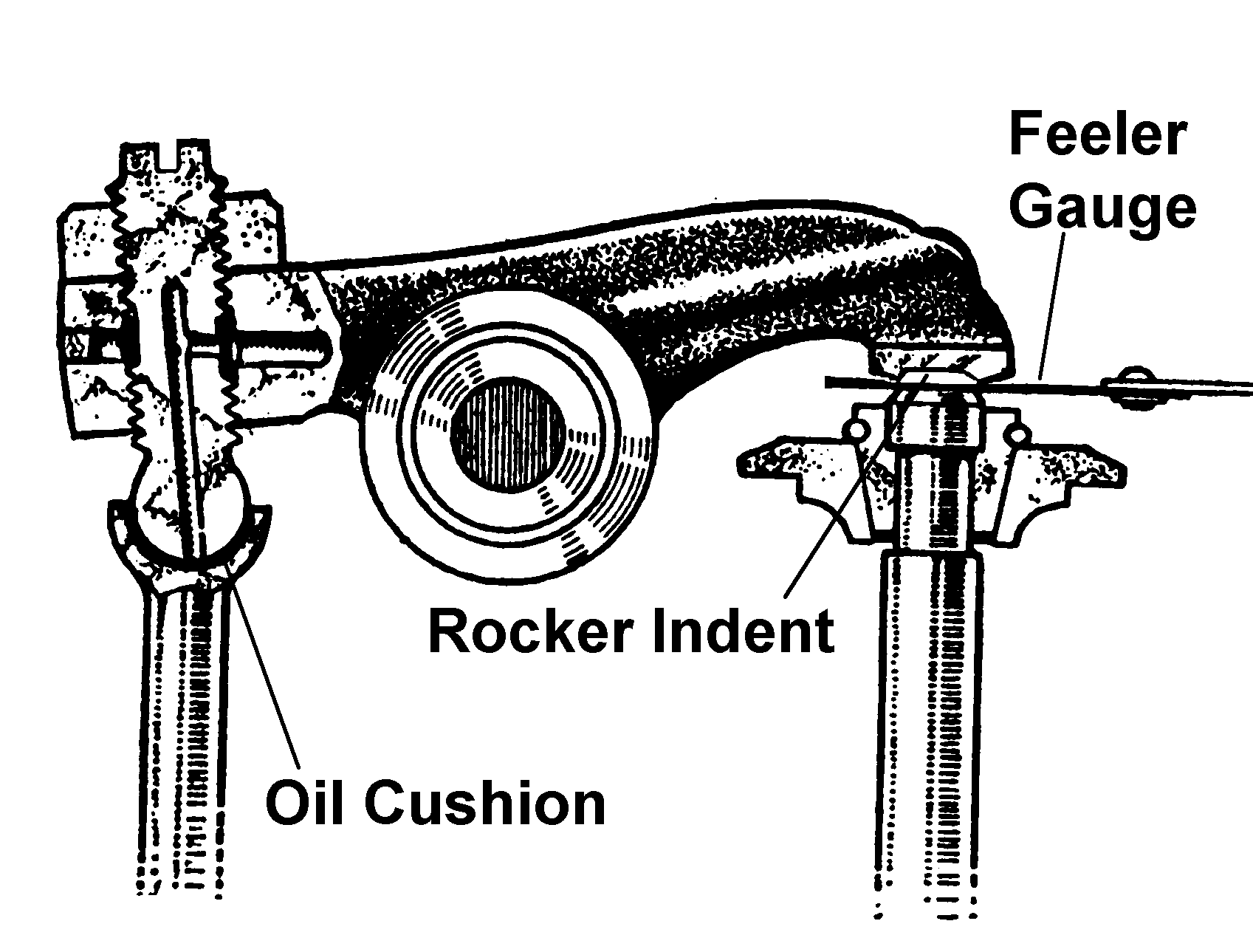After an engine has covered a high mileage it is likely that an indent will have been worn in the rocker where it hits the top of the valve. This is shown in the illustration opposite. Note that this is not an RM rocker and is used for illustrative purposes only. If the indent is large the rockers should be removed from the rocker shaft and the profile of the contact pad (slightly curved) should be reground to eliminate the indent. If it is not too large it may be left but it should be remember that the clearances as set will to too great by the depth of the indent. Another possible of cause of clearance setting error is the thickness of any oil film in the cup at the top of the push rod. Before finally setting the clearance it is a wise precaution to tighten down the adjusting screw against the push rod to drive out any residual oil film. Do not do this with a feeler gauge blade in place as it may be damaged.
To set the clearances first remove one of the rocker box covers, release the four locking nuts on the clearance adjusting screws and slacken off each adjusting screw a couple of turns. This is done to prevent any confusion later over whether a particular screw has been adjusted or not. It also makes life easier if all the spark plugs are removed.
Clearances must only be set when the valve in question is fully closed. This means that the cam follower (tappet) must be on the back of the cam on the camshaft i.e. on the rounded part of the cam and not on then raised part. The fool proof way of doing this is the turn the engine on the starting handle until the valve to be set is fully open (down) and then turn the engine one complete revolution. Since the camshaft turns at half the speed of the crankshaft a full turn of the crankshaft equates to a half turn of the camshaft. The only problem with this method is that it involves a lot of handle turning. Fortunately there is an easier way.
Most people are aware that on a four cylinder inline engine having a single rocker shaft with 8 rockers the Rule of Nine can be used. In the case of an RM rocker shaft where there are only 4 rockers this becomes the Rule of Five. Calling the valve at the front of the engine No.1 and the one at the one at the back No.4, we adjust No.1 valve clearance when No.4 valve is fully open (depressed by its rocker) i.e. 1 + 4 = 5. Now give the engine just half a turn and watch until No.3 valve is fully open (depressed) and adjust No.2 valve clearance (2 + 3 = 5). Give the engine a further half turn and No.1 valve opens (depress) so we can adjust the clearance for valve No.4 (4 + 1 = 5). One more half turn will open valve No.2 so we can adjust valve No.3 (3 + 2 = 5). As each valve is adjusted make sure that the locking nut is tighten fully. When all 4 clearance have been set check that all the locking nuts are tight to ensure that they have indeed all been set. Finally replace the rocker box cover and carry out the same procedure on the other set of valves and replace the sparking plugs.
That's all there is to it and you should now have a smooth running and quiet engine unless there is something else wrong. If there is now might be a good time to carry out a compression test. Ideally this should be done with a proper compression tester but you can get a good idea of any problems just by turning the starting handle and feeling the compression. If there are four firm and equal compressions then everything is probably OK but if they are not even, particularly if one is much less firm than the others, then there is another problem.
To find out whether the problem lies in the valves or the pistons pour a spoonfull or so of engine oil into each cylinder through the spark plug hole, replace the spark plugs, turn the engine over slowly a couple of times to spread the oil around the pistons and bores and repeat the test. The oil will give a temporary improvement in the seal between the pistons and the bores so if the compressions improve after adding the oil the problem lies in the pistons/bores. If there is no improvement the problem lies with the valves.
